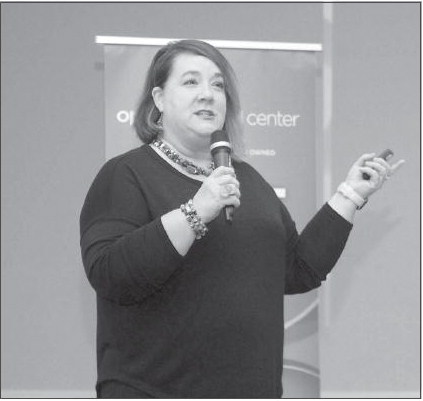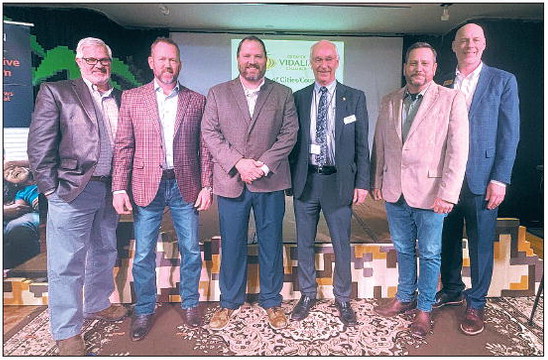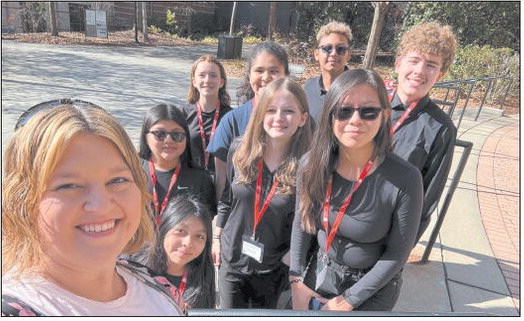ConnectHER Emphasizes Work-Life Harmony


mrandolphadvance@gmail.com
The annual ConnectHER event, held on March 23, filled the Vidalia Community Center with chatter and commerce, as women throughout the surrounding communities gathered to shop, reconnect, and hear a message emphasizing the importance of harmony between work and life.
“How many of you feel like your own personal “check engine” light is on?” keynote Speaker Anissa Starnes asked the crowd. “What do we normally do when our ‘check engine’ light comes on in the car? Most of the time, we are too busy to immediately take it and get it fixed, so we put it off, and we keep driving it, and keep driving it, and keep driving it until it stops. And that’s unfortunately what we do with our bodies sometimes. We say, ‘It’s good. I can keep going. I don’t need to stop.’ We can’t really do that because we’re not designed to do it, just like our cars aren’t designed to do it.” Harmony, Not Balance
Starnes began her address by clarifying the difference in work-life balance and work-life harmony. “I know that you probably saw ‘Work-Life Balance’ on the screen, and you immediately said, ‘Oh, here we go again. Somebody else is going to tell us how to get our life in balance,’” she explained. “I’m not going to tell you that because I don’t believe in work-life balance. I think that at any time, we are out of balance – we are heavy on the work, heavy on the family, and sometimes, they fight each other. Rarely are we in the middle to where there is a complete balance of work and life.”
She shared that her 10 tips for life were not to promote balance between work and life, but rather harmony. “I do believe in work-life harmony, [which focuses] on how the two work together,” Starnes remarked. “It took me many years to learn some of these tips. I’ve picked them up along the way, I’ve tried to institute them into my own life, and every single time I give this presentation, I change it because I learn something else I can put in my tool kit. Every time I give this presentation, it reminds me to check myself.”
Work-Life Struggle As she shared an anecdote, Starnes provided the audience with an example of the stress and struggle which work may place on individuals’ personal lives.
“Sometimes, we just have to let things go and realize that we cannot make everybody happy at one time. Even though we might try, there are some things we just can’t do. For instance, my phone went off during dinner. I had it on vibrate, but my phone went off, my watch went off, and then my phone went off again – it was a third time. I thought, ‘Something has to be happening.’ I checked my text messages and it was someone I did not even know because they weren’t in my phone,” she told the crowd.
The person who had texted Starnes was one of the clients of her business who informed her that they had forgotten to ask for something and wanted to see if she could email it to them at that moment. “I can’t do it, I don’t have my laptop with me, and even if I did, it would be weird to pull it out at the table and start doing it. So, I shot a text message back and said, ‘Hey, I’m at another Chamber event, I can’t get to it right now, I’ll reach back out to you in the morning.’ To which, he came back and said, ‘I need it tonight, can you text Karen and have her do it?’” Starnes continued.
She went on to explain that Karen was her coworker, who had her own family and children she was spending time with that night. “Now, maybe 3-4 years ago, I would have emailed Karen and said, ‘Hey, can you do this for our client?’ It’s not life or death, I know what it is, it can wait until tomorrow. But, I thought to myself, ‘No, I’m not going to text Karen at 7 o’clock at night while she’s eating dinner, maybe feeding her 4 year old, because then she’s going to have to stop what she’s doing and switch gears. So, I went back to the client and said, ‘I’m not going to bother Karen with it tonight. If it’s OK, I’ll ask her to do it first thing in the morning or I’ll do it first thing in the morning,’” she added.
“It’s just setting boundaries,” she emphasized. Understanding Stress
Before she began sharing tips on setting boundaries and having harmony within the various parts of life, Starnes clearly defined stress and its effect on everyday life. “I think everybody in this room knows what stress is and how bad it is for us and what it can do to us,” she said. “We can feel it – sometimes, it is a heaviness in the chest; sometimes, it’s waking up at 3 a.m., 4 a.m., 5 a.m., worrying about something. We start ruining our Sundays by worrying about our Mondays. We keep going, going, going until we feel like we can’t do it and just need some time, and that time never comes.”
She also explained how the COVID-19 pandemic had increased stress within society. “Certainly, over the last 3 years, we have had stress get worse tenfold,” she told the group. “I was supposed to be here with you all in March 2020. [Greater Vidalia Chamber Executive Director] Debbie [Evans] and I were just talking and remembering kind of laughing after the fact because when we were deciding in 2020 whether I was going to be able to come. They had just started making shutdowns, and I said, ‘We’ll just probably be home a day or two. Surely, I’ll be back on the road next week.’ But little did we know.”
“It has created all of this stress that we did not have before and it has compounded it. So, hopefully, these tips that I am going to share with you are going to be even more helpful than they would have been 3 years ago because we’re dealing with a lot of stuff now that we were not dealing with before,” Starnes added.
The Tips Phone-Free Hours Starnes advised attendees to spend an hour after waking up and an hour before bed without their phones or other technological devices.
She stated she believed this tip is the hardest to accomplish, as most individuals have their phones attached to them, even while sleeping. “Some of y’all are sitting there like ‘I’m not going to do that, it’s too hard. I sleep with my phone under my hand. It’s on my night stand and at some point in the middle of the night, it gets in the bed, and then, when I can’t find it, I look like a crazy woman going all over the bed trying to find it because it’s an appendage.’ When we can’t find it, we get uncomfortable. But this is something that I did and it stuck,” Starnes reassured.
“It was so hard the first week or two, but then, it just became a habit,” she explained. Starnes informed the audience that she decided not to get on her devices in the mornings until after she had showered, drank her coffee, talked with her husband, and walked her dog. She also said she has the same practice an hour before she goes to bed; she even leaves her phone on a nightstand outside of her door where she can still hear an emergency call but cannot easily access it from the bed.
“Nothing is going to happen if you do not see those emails at 6:30 a.m. You don’t know to stress about it. So, wait until you have done whatever you’d like to do in your morning routine first,” she advised. Utilizing Do Not Disturb on Phones She informed the audience that iPhone users have a feature on their phone where they may block any calls or messages except for a select few, which the phone’s user determines through their selection of favorites. She said this is important, as the boundaries between work and life need to be clearly defined.
“It’s just like my client – I love him. I didn’t even know he knew my cell phone number; we’ve never communicated via text message before. But because we knew each other, he thought it was okay to text me at 7 [p.m.] and ask me to do something. Normally, it’s never a big deal – what he’s asking would take me probably 10 minutes – but you’ve got to start setting those boundaries of ‘I’ll do that tomorrow instead of tonight,’” Starnes told the group.
Volunteering
According to Starnes, it is important to not only volunteer in the community, but to also volunteer in things which you are passionate about. “How many of you volunteer for something that you want to volunteer for? Or were you just ‘voluntold’ that you needed to volunteer for something?” she asked the crowd. “A lot of us sit on boards through our work, we sit on committees at our kids’ schools or the Home Owners’ Association. We volunteer for things we have to volunteer for.”
She continued, “The number one thing I have done for myself as far as volunteering is [that] I started saying ‘no’ for things that I was not extremely passionate about, and found one thing that I was really passionate about that I could volunteer for that I really wanted to give my time to, because it makes me feel good. It is working toward something that I genuinely in my heart care about.” Understanding How to Be a Good Boss/Worker Starnes emphasized the importance of understanding what it means to be a good boss or employee in your work.
“It really works for everyone – just being understanding of what it means to be a good boss or what it means to be a good staff person to your boss,” she explained. “Whether that means giving yourself permission to take care of yourself, or giving your team permission to take care of themselves.”
She exemplified this concept by encouraging bosses to allow themselves and their workers to leave work early for events with their children or family, and being conscientious of the times that they send texts or emails.
“We have become a society of immediate response. I emailed someone earlier this week, and I got a response back that said, ‘Anissa, I am so sorry that I’m just now getting back to you. I’ve had a crazy week and I’m running everywhere,’ and I said, ‘It’s been 8 minutes,’” Starnes said with a laugh. “Nothing in my email said ‘My hair is on fire, please come running!’ It was just a simple, “Hey, when you get a second, can you send me something?’ but she was apologizing for taking 8 minutes.”
She utilized the story to further stress the importance of being aware when emails are sent as part of being a good boss. Also, she told the bosses in the room to make sure to do as they say. “If you tell your staff to take the day off, you need to take the day off with them and not be working, because if they then see that you’ve been working, they will feel guilty about it,” she added.
According to Starnes, understanding the home environment and being aware of people’s home life to know when to allow them breaks or to work from home is also imperative to being a good boss and worker. “We have to get toward trusting people that they’re going to do what they need to do when they’re working from home or in flexible timing,” she said. Knowing When to Ask for Help Knowing when to take a break or ask for help on a project is one of the many ways harmony can be promoted between life and work, Starnes told the group.
She gave her own personal experience with this. “Just recently, we moved my 92 year-old aunt, for whom I am caretaker, to assisted living and we were cleaning out her condo. It was just me, and I thought I could do it on the weekends, but finally, I hit a wall and said, ‘Hey, I have got to take 3 days off,’” Starnes remarked. “My boss – God love him – immediately said, ‘Do I need to get on a plane? Can I come help? I can pack boxes, I can drive a U-Haul, what do you need?’ I told him I needed a break and he gave it to me, no questions asked.
Meeting-Free Days
According to Starnes, meeting-free days should also be made a part of the work schedule for work-life harmony. She explained that it is completely up to the individual how often to schedule these days – weekly, monthly, quarterly, etc. She told the group that they did not have to let people know that those days were meeting-free days, but rather just merely tell people that we are fully booked.
“What we do as women is we people please, and we say ‘yes’ when we really need to say ‘no,’” she emphasized. “We have to give ourselves that time to work on our business and not at our business. Having a quiet day in the office where you can get the real work done is very important, because if we don’t pay attention, our calendars get really, really, really full.”
Saying “No”
She stressed the importance of learning when to say “no” to events and requests when necessary. “Get used to saying ‘no’ when someone comes to you if it doesn’t need to be on your plate, if it absolutely can’t fit, and if you absolutely have no desire to do it – we spend so much time doing things we do not want to do because we feel obligated to do it, and really, it’s absolutely OK to say no,” Starnes said. Putting Yourself on the Schedule Starnes told the group that it is important for individuals to put themselves on a daily schedule for activities which they desire to do. She gave the example of her scheduling a pilates class during her day, and merely telling any clients that she is unavailable at that time. “You have to take time for yourself, and make it non-negotiable at all costs unless it is an emergency,” she emphasized. “No one has to know what you are doing, they just need to know you are unavailable at that time. You have to remember you are so valuable – you’re valuable to yourself, to your coworkers, to your boss, and to your family. Not putting yourself on your schedule will burn you out.’” Finding Joy
Joy should be found wherever and through whatever means possible to avoid burning out. “It doesn’t have to be a big trip, it just has to be whatever brings you joy – put it on your schedule. Try to work it in whenever you can,” she commented.
Dance Everyday
She ended her list of tips with her advice to the audience to dance every day. “You can’t be upset when you’re dancing…it’s a joyful thing,” Starnes remarked. She told the audience that she spent many days having her own dance parties in her house during the COVID pandemic and discovered an increase of joy and decrease of stress.
About Starnes
Starnes has more than 30 years of experience in nonprofit management, which mostly dealt with chambers of commerce. She currently serves as the Chief Impact Officer or YGM Total Resource Campaigns, a nationwide firm that assists chambers with non-dues revenue development and nationwide executive searches.





